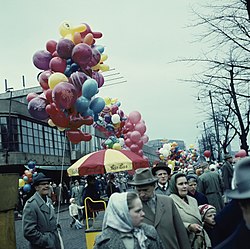Walpurgis Night
Walpurgis Night (Valborgsmässoafton in Swedish, Vappu in Finnish, Volbriöö in Estonian, Valpurģu nakts or Valpurģi in Latvian, Walpurgisnacht in German, Čarodějnice in Czech) is a holiday celebrated on April 30 or May 1, in Finland, Sweden, Bohemia (Czech Republic), Estonia, Latvia and Germany.
Origins
The festival is named after Saint Walburga (known in Scandinavia as "Valborg"; alternative forms are "Walpurgis", "Wealdburg", or "Valderburger"), born in Wessex in 710 a niece of Saint Boniface. According to legend, she was a daughter to the Saxon prince St. Richard. Together with her brothers she travelled to Württemberg, Germany where she became a nun and lived in the convent of Heidenheim, which was founded by her brother Wunibald. Walburga died on 25 February 779 and that day still carries her name in the Catholic calendar. However she was not made a saint until 1 May in the same year, and that day carries her name in the Swedish calendar.
Historically the Walpurgisnacht is derived from Germanic Pagan spring customs, where the arrival of spring was celebrated with bonfires at night. Their fertility celebrations took place around April 30 and due to Walburga being declared a saint at that time of year, her name became associated with the celebrations. Walburga was worshipped in the same way that the Germanic Pagans had celebrated spring, and as it spread throughout Europe, the two dates became mixed together and created the Walpurgis Night celebration.
Germany
In Germany, Walpurgisnacht, the night from April 30 to May 1, is the night when allegedly the witches hold a large celebration on the Blocksberg and await the arrival of Spring. When the travel to that mountain is too far, they may also chose another hill in the region they live.
"Walpurgis Night (in German folklore) the night of April 30 (May Day's eve), when witches meet on the Brocken mountain and hold revels with their Gods..."
"Brocken the highest of the Harz Mountains of north central Germany. It is noted for the phenomenon of the Brocken spectre and for witches' revels which reputably took place there on Walpurgis night. The Brocken Spectre is a magnified shadow of an observer, typically surrounded by rainbow-like bands, thrown onto a bank of cloud in high mountain areas when the sun is low. The phenomenon was first reported on the Brocken."
—Taken from Oxford Phrase & Fable.
Walpurgis Night Media
A Christian gonfalon depicting Saint Walpurga used in liturgical processions on the Feast of Saint Walpurga
The relics of Saint Walpurga are housed at Saint Peter's Church in Munich, where they are venerated, especially on 25 February (Saint Walpurga's death date) and 1 May (Saint Walpurga's canonization date), both of which are observed as the Feast of Saint Walpurga, depending on locality.
People at a vappu picnic in Kaivopuisto in 2008
The crowd in front of Lasipalatsi in Helsinki, in 1960
Vappu celebration in front of a Kuopio Market Hall in Kuopio
Sugar-coated doughnuts and sima are typical vappu delicacies in Finland
Lewis Morrison as "Mephistopheles" in Faust!: "The Brocken". Poster for a theatrical performance of Goethe's play showing Mephistopheles conjuring supernatural creatures on the German mountain, the Brocken (or Blocksberg), which according to the tale is the scenery for the Walpurgisnight, from 30 April to 1 May








